+Search query
-Structure paper
| Title | Cork-in-bottle mechanism of inhibitor binding to mammalian complex I. |
|---|---|
| Journal, issue, pages | Sci Adv, Vol. 7, Issue 20, Year 2021 |
| Publish date | May 14, 2021 |
 Authors Authors | Injae Chung / Riccardo Serreli / Jason B Cross / M Emilia Di Francesco / Joseph R Marszalek / Judy Hirst /   |
| PubMed Abstract | Mitochondrial complex I (NADH:ubiquinone oxidoreductase), a major contributor of free energy for oxidative phosphorylation, is increasingly recognized as a promising drug target for ischemia- ...Mitochondrial complex I (NADH:ubiquinone oxidoreductase), a major contributor of free energy for oxidative phosphorylation, is increasingly recognized as a promising drug target for ischemia-reperfusion injury, metabolic disorders, and various cancers. Several pharmacologically relevant but structurally unrelated small molecules have been identified as specific complex I inhibitors, but their modes of action remain unclear. Here, we present a 3.0-Å resolution cryo-electron microscopy structure of mammalian complex I inhibited by a derivative of IACS-010759, which is currently in clinical development against cancers reliant on oxidative phosphorylation, revealing its unique cork-in-bottle mechanism of inhibition. We combine structural and kinetic analyses to deconvolute cross-species differences in inhibition and identify the structural motif of a "chain" of aromatic rings as a characteristic that promotes inhibition. Our findings provide insights into the importance of π-stacking residues for inhibitor binding in the long substrate-binding channel in complex I and a guide for future biorational drug design. |
 External links External links |  Sci Adv / Sci Adv /  PubMed:33990335 / PubMed:33990335 /  PubMed Central PubMed Central |
| Methods | EM (single particle) |
| Resolution | 3.04 Å |
| Structure data | EMDB-12095, PDB-7b93: |
| Chemicals |  ChemComp-SF4: 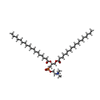 ChemComp-PC1: 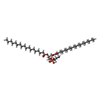 ChemComp-3PE: 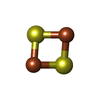 ChemComp-FES: 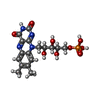 ChemComp-FMN: 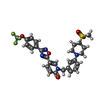 ChemComp-T2Q: 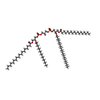 ChemComp-CDL:  ChemComp-ATP: 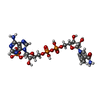 ChemComp-NDP:  ChemComp-ZN: 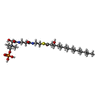 ChemComp-EHZ: |
| Source |
|
 Keywords Keywords | OXIDOREDUCTASE / Inhibitor / Ubiquinone / Complex I |
 Movie
Movie Controller
Controller Structure viewers
Structure viewers About Yorodumi Papers
About Yorodumi Papers






